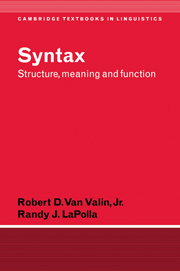Book contents
- Frontmatter
- Contents
- List of figures
- List of tables
- Acknowledgments
- Notes for instructors
- List of abbreviations
- 1 The goals of linguistic theory
- 2 Syntactic structure, I: simple clauses and noun phrases
- 3 Semantic representation, I: verbs and arguments
- 4 Semantic representation, II: macroroles, the lexicon and noun phrases
- 5 Information structure
- 6 Grammatical relations
- 7 Linking syntax and semantics in simple sentences
- 8 Syntactic structure, II: complex sentences and noun phrases
- 9 Linking syntax and semantics in complex sentences
- Epilog: the goals of linguistic theory revisited
- Notes
- References
- Index of languages
- Subject index
2 - Syntactic structure, I: simple clauses and noun phrases
Published online by Cambridge University Press: 05 June 2012
- Frontmatter
- Contents
- List of figures
- List of tables
- Acknowledgments
- Notes for instructors
- List of abbreviations
- 1 The goals of linguistic theory
- 2 Syntactic structure, I: simple clauses and noun phrases
- 3 Semantic representation, I: verbs and arguments
- 4 Semantic representation, II: macroroles, the lexicon and noun phrases
- 5 Information structure
- 6 Grammatical relations
- 7 Linking syntax and semantics in simple sentences
- 8 Syntactic structure, II: complex sentences and noun phrases
- 9 Linking syntax and semantics in complex sentences
- Epilog: the goals of linguistic theory revisited
- Notes
- References
- Index of languages
- Subject index
Summary
Introduction
In this chapter we investigate the structure of phrases and clauses in simple sentences. There are two fundamental aspects of structure which every theory must deal with: relational and non-relational structure. As the names imply, relational structure deals with the relations that exist between one syntactic element and another, be they syntactic, semantic or pragmatic in nature, whereas non-relational structure expresses the hierarchical organization of phrases, clauses and sentences, however it may be conceptualized. Semantic relations are the focus of chapters 3 and 4, and pragmatic relations are the main subject of chapter 5. Syntactic relational structure is the main topic of chapter 6, which focuses on grammatical relations. We will concentrate on the non-relational structure in simple phrases and sentences in this chapter. The structure of complex noun phrases and sentences is discussed in chapter 8.
Before we begin, however, there are two general theoretical issues that need to be addressed: how many levels of syntactic representation are there in a grammar, and what aspects of clause structure are universal? These issues will be considered in the next section.
General theoretical issues
Levels of syntactic representation
One of the most important theoretical claims Chomsky made in his early work was that no theory of grammar could approach descriptive or explanatory adequacy if it recognized only a single level of syntactic representation, namely the overt or surface form. He argued that an additional, abstract level of syntactic representation is required.
- Type
- Chapter
- Information
- SyntaxStructure, Meaning, and Function, pp. 17 - 81Publisher: Cambridge University PressPrint publication year: 1997

